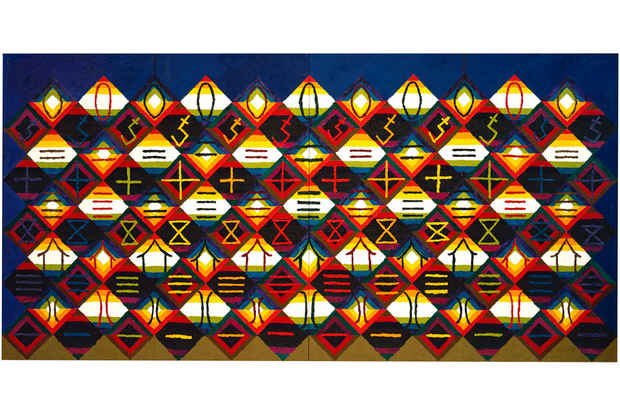Alfred Jensen / Sol LeWitt "Systems and Transformation"
The Pace Gallery (32 E 57th St)

This event has ended.
Exhibited side-by-side, Jensen’s colorful and tactile abstract paintings and LeWitt’s minimalist white structures reveal the vastly different outcomes that can arise from similar conceptual foundations. Jensen uses mathematical systems to construct two-dimensional grid paintings and demonstrate color theories, but the work itself is metaphorical, referencing pre-Colombian and Asian cultures, textiles, and divination. LeWitt’s three-dimensional grid sculptures, in contrast, are self-referential, rooted in logic and reality, and governed by mathematical instructions that objectively organize space. The exhibition will include eight paintings by Jensen and eight open geometric structures by LeWitt.
Jensen's intricately organized diagrams reflect his distinctive conceptual approach, begun in the late 1950s when he started to refine his wide-ranging studies of systems and philosophies—from theories of color and light, mathematics, and the Mayan calendar, to scientific formulations—into multicolored checkerboards. The paintings on view, made between 1960 and 1975, include one of Jensen’s largest and most complex works, "A la Fin de l’automne" (1975). A honeycomb of color, numbers, and symbols, the elements alternate between light and dark, with each square bearing an abstract marker. Jensen had travelled to Brazil and Peru just one year earlier, and the work suggests the pattern of a pre-Colombian tapestry rendered in thick impasto.
In contrast, LeWitt’s austere open structures, made from basic geometrical units arranged according to pre-determined mathematical sequences, reflect their own poetics. A pillar of minimalist and conceptual art, Sol LeWitt helped revolutionize the definition of art in the 1960s with his famous declaration that “the idea becomes a machine that makes the art.” Reducing art to its essentials, the cube became the basic modular unit for his artistic inquiry—the “grammatical device” from which his work would proceed. A universally recognizable form that could not be mistaken to represent anything other than itself, the cube eliminated the necessity of inventing another form, allowing the form itself to be used for invention. The exhibition will feature all manner of structures of forms derived from the cube, made out of wood or aluminum and painted white, from between 1971 and 1997, including the ceiling-mounted work "Hanging Structure" (1992), and a maquette for an outdoor structure similar to those recently featured in the Public Art Fund’s landmark survey exhibition "Sol LeWitt Structures: 1965–2006," installed in New York’s City Hall Park from May to December 2011.
Concurrently, Pace has installed a monumental concrete block structure by Sol LeWitt on the roof of its Chelsea gallery at 510 West 25th Street, which is visible from the High Line. The structure, "Horizontal Progression" (1991), continues LeWitt’s interest in generating variety within self-imposed constrictions, moving only horizontally, vertically, or diagonally to the left or right.
[Image: Alfred Jensen "A la fin de l'automne" (1975) oil on canvas, four panels, overall: 6 ft. 2 in." x 12 ft. 4 in. © Estate of Alfred Jensen/Artists Rights Society (ARS), New York. Photo by: Bill Jacobson/Courtesy The Pace Gallery.]
Media
Schedule
from January 13, 2012 to February 11, 2012